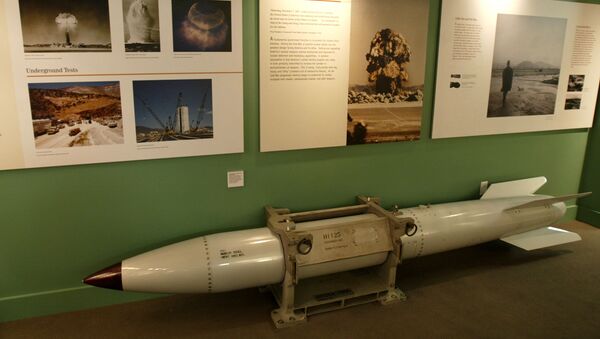Washington's flight test of its B61-12 gravity nuclear bombs in Nevada doesn't appear to be a confrontational move, Michael O'Hanlon, Director of Research for the Foreign Policy program at Brookings Institution, told Radio Sputnik, adding that the creation of a new bomb is more about reliability and safety rather than developing a new class of warhead.
"The test here is essentially everything around the bomb: it's the aerodynamics by which the bomb would be delivered, you know, it's the basic desire to have the weapon be accurate… it's trying to make the weapon, I think, more reliable and that's the essence of what the ongoing US nuclear warhead modernization is all about," O'Hanlon said.
The scholar called attention to the fact that neither the United States, nor Russia nor any other established nuclear power has tested nuclear weapons with an actual nuclear detonation in about 20 years.
In fact all these years the global players have been complying with the UN's Comprehensive Nuclear-Test-Ban Treaty (CTBT) of 1996 although it has never been ratified, the American scholar noted.
According to O'Hanlon, the comprehensive program of replacing old B61 bombs stationed in Europe with the modified B61-12 is "not meaningful in military terms." The scholar stressed that he saw it primarily as "an issue of reliability and safety and maybe some slightly improved performance on accuracy."
The scholar bemoaned the deterioration of US-Russian relations: according to O'Hanlon, "both Russia and the US are still locked in a little bit of legacy of nuclear rivalry in the context of the overall relationship that's been strained for several years."
On the other hand, the scholar noted, the number of nuclear bombs currently deployed in Europe, about a hundred and fifty, is relatively "modest" in comparison with total arsenal of Russia or the United States.
Still, "It's a big number when you think about the explosive power of these weapons, that's why I wish we were talking about how to get rid of all of them rather than how to replace them," the American scholar remarked.
"The good news is that I don't see it as improving military offensive capabilities, I see this primarily in terms of reliability and safety," O'Hanlon reiterated.
He surmised that the test was by no means a signal to US geopolitical competitors or a sort of confrontational or provocative move. Likewise, the scholar rejected the idea that the US' recent B61-12 test was a "message" to North Korea, "except in the sense of a general reminder that [the US] has a powerful nuclear force."
However, it appears that American nuclear expert Dr. Hans Kristensen shares a different stance.
Speaking to Radio Sputnik on Wednesday Kristensen assumed that the B61-12 flight test sent a signal to Moscow.
"Nuclear weapons are used to signal," Kristensen said. "The ones [deployed] in Europe now have been used to signal, from NATO's point of view, the defense of NATO against a potential attack from Russia and these new weapons, which will come to Europe in the early part of the next decade, will also serve that role."
On August 29 the National Nuclear Security Administration (NNSA) announced the successful conclusion of flight tests of its B61-12 gravity bombs without nuclear warheads. The qualification tests were conducted on August 8 at the Tonopah Test Range in Nevada. The bombs were dropped from F-15E fighter jets.
The NNSA said in an official statement that the "tests are part of a series over the next three years to qualify the B61-12 for service." The first qualification flight test was conducted in March 2017.



